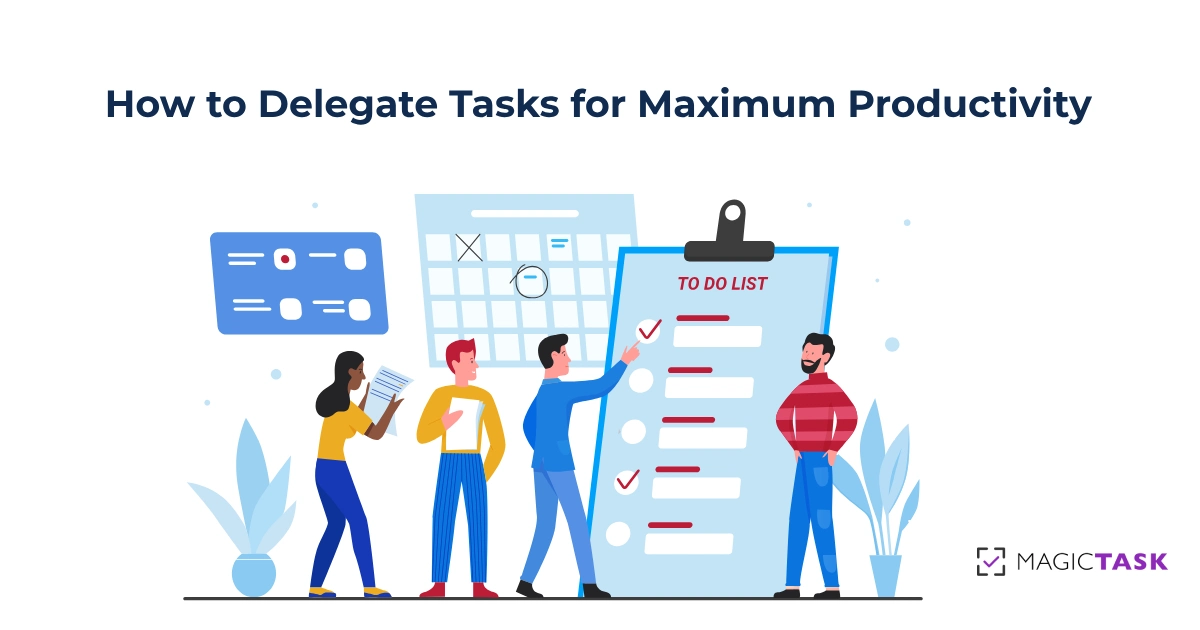How to Delegate Tasks for Maximum Productivity

Have you ever felt so bogged down by small tasks that you barely had time for the bigger picture? You’re not alone—75% of managers face the same challenge daily.
Mastering the art of task delegation can free up your valuable time and help you focus on high-priority tasks while empowering others to take ownership of responsibilities.
But, effective delegation isn’t just about handing off work—it’s about strategically assigning tasks to the right people, ensuring alignment with their skills and expertise. When done correctly, delegation enhances overall productivity and fosters collaboration and growth within a team.
In this guide, we’ll talk about the benefits of delegation, share easy steps to do it right, and explore tools to make task management a breeze.
Let’s get started!
Why Delegation Matters?
Delegation is a cornerstone of effective leadership. It offers numerous benefits, such as:
- Reduces workload and prevents burnout: By sharing responsibilities, leaders can focus on strategic tasks, reducing stress and avoiding burnout.
- Empowers team members and builds trust: Assigning tasks to others fosters a sense of ownership and confidence, strengthening trust within the team.
- Improves team efficiency and productivity: Delegation allows tasks to be handled by those best suited for them, enhancing overall team performance.
Conversely, poor delegation can lead to micromanagement, missed deadlines, and decreased morale, underscoring the importance of mastering this skill.
Challenges in Delegating Tasks
Delegating tasks often come with a set of fears and reservations, which can hold back even the most efficient professionals. Common concerns include:
-
“What if it’s not done correctly?”
This fear stems from a lack of trust or confidence in others’ abilities. The solution lies in providing clear instructions and ensuring expectations are well-communicated. When team members know exactly what’s required, they’re more likely to deliver quality results. -
“I can do it faster myself.”
While this may be true in the short term, consistently handling every task yourself can lead to burnout and limit productivity. Delegating tasks to others may take initial effort, but it ultimately frees up time for more critical responsibilities. -
“It’s hard to let go of control.”
For many, letting go of tasks feels risky. Using tools to monitor progress, like task management platforms, can provide peace of mind. By tracking milestones and outcomes, you retain oversight without micromanaging.
Addressing these fears with practical solutions makes delegation easier and strengthens team collaboration and efficiency.
Steps to Delegate Tasks Effectively
Delegation isn’t just about assigning tasks—it’s about creating a system where work is distributed strategically, aligning responsibilities with the strengths and capacities of your team. When approached thoughtfully, it can transform how you and your team operate, leading to greater productivity and growth. Here’s how to delegate effectively:
Step 1: Identify What to Delegate
The first step in delegation is deciding which tasks can and should be handed off. Think about the work consuming too much of your time or requiring a skill set that others in your team might already excel at. Consider these categories:
- Time-intensive tasks that pull you away from strategic responsibilities.
- Repetitive activities that can be streamlined by someone else.
- Lower-priority items that don’t require your direct attention but still need completion.
By being selective and intentional, you’ll ensure your focus remains on high-value work.
Step 2: Choose the Right Person
Once you know what needs delegating, the next step is finding the best person to take it on. This involves matching the task to someone whose skills, interests, and workload make them the ideal fit.
Consider who can take on additional responsibilities and who might benefit from a growth opportunity. Delegating thoughtfully strengthens your team’s engagement and ensures tasks are completed efficiently.
Step 3: Communicate Clearly
To set your team up for success, it’s essential to provide clarity about what needs to be done and how. Explain the task’s objectives, its importance, and your expectations. Be specific about deadlines and priorities, but avoid micromanaging how the work gets done.
For instance, instead of saying, “Write a report,” be clear about the scope: “Draft a one-page summary of quarterly sales, highlighting key trends and insights.”
Clear communication empowers your team to meet or exceed expectations.
Step 4: Set Deadlines and Priorities
Effective delegation requires a clear timeline. Establish realistic and meaningful deadlines, ensuring the task aligns with your team’s broader goals.
Prioritizing tasks also helps avoid confusion, especially when juggling multiple responsibilities. Leveraging task management tools can make organizing and communicating these priorities seamless.
Step 5: Monitor Progress Without Micromanaging
While it’s essential to stay informed about progress, hovering over every detail can be counterproductive. Use tools like dashboards or check-ins to track milestones and address any roadblocks.
This approach balances trust and accountability, creating a sense of ownership while keeping projects on course.
Step 6: Provide Feedback
Delegation is also an opportunity for development. Offering constructive feedback helps your team refine their skills while recognizing good work boosts motivation and morale.
Celebrate their contributions and provide insights for improvement—it’s a win-win that fosters growth and trust.
Bonus Tips for Effective Delegation
As you refine your delegation approach, consider these advanced strategies:
- Trust your team and avoid the urge to micromanage. Instead, guide them when needed and focus on outcomes, not processes.
- When delegating tasks, share the bigger picture—what’s the end goal? This empowers your team to take ownership and make informed decisions.
- Save time with templates for recurring tasks. These standardized frameworks make delegation faster and more consistent.
By following these steps and strategies, you’ll lighten your workload and create a more engaged and capable team, setting everyone up for long-term success.
Common Mistakes to Avoid When Delegating Tasks
Delegation can seem deceptively simple, but subtle missteps can derail even the best-intentioned efforts. Here are some lesser-discussed mistakes that can undermine your delegation strategy:
1. Delegating Without Considering Team Dynamics
Leaders often overlook how interpersonal relationships and team dynamics affect task execution. Assigning a task to someone who struggles to collaborate with others or pairing conflicting personalities can create unnecessary friction, delaying progress.
Avoid it by: Pairing tasks with individuals or teams that work well together, fostering a collaborative and positive work environment.
2. Delegating Based on Availability Instead of Capability
It’s easy to hand off tasks to whoever appears least busy, but availability doesn’t always align with skill or interest. Delegating this way can result in subpar results and missed opportunities for personal growth.
Avoid it by: Assessing who has the right skill set and passion for the task, even if it takes longer to distribute work.
3. Relying Solely on Verbal Instructions
Verbal communication alone can lead to misunderstandings, especially for complex tasks. Without a written reference or checklist, team members may forget critical details, leading to rework and wasted effort.
Avoid it by: Documenting tasks clearly in writing, using tools to track responsibilities, and providing accessible resources for clarification.
4. Not Delegating “Upward” When Necessary
Delegation isn’t just about passing tasks down the chain—it also involves knowing when to escalate responsibilities. Failing to delegate upward to your own leadership when facing resource constraints or needing strategic direction can leave you overburdened and the task at risk.
Avoid it by: Recognizing when tasks or decisions require higher-level input and communicating these needs effectively to your leaders.
5. Assuming Delegation Ends With Task Completion
Delegating tasks is often treated as a one-and-done process, but it’s also an ongoing opportunity to evaluate and optimize workflows. Leaders who fail to review and learn from the delegation process miss out on ways to improve efficiency and strengthen their team.
Avoid it by: Conducting post-task reviews to identify what worked well and what could be done better next time, ensuring continuous improvement.
How MagicTask Can Help Delegate Tasks Effectively
Delegating tasks is only as effective as the tools you use to manage and monitor progress. MagicTask streamlines the delegation process, enabling leaders and teams to work smarter, not harder.
With its user-friendly interface and powerful features, MagicTask makes assigning, tracking, and completing tasks a seamless experience. Here’s how it can help you delegate more effectively:
1. Simplified Task Assignment
MagicTask allows you to assign tasks in just a few clicks. You can match tasks to the right people by detailing the skills required and setting clear priorities. Customizable fields ensure that your team has all the necessary information upfront, reducing the chance of misunderstandings or delays.
2. Clear Communication of Goals and Expectations
With MagicTask, you can attach detailed instructions, set deadlines, and outline desired outcomes for every task. This ensures that your team understands what needs to be done and why it matters. Features like comments and file sharing enable ongoing collaboration, keeping communication centralized and efficient.
3. Prioritization Made Easy
MagicTask’s intuitive prioritization tools let you label tasks by urgency and importance. Whether you’re dealing with high-stakes projects or routine responsibilities, the platform ensures that everyone knows what to tackle first, avoiding bottlenecks and confusion.
4. Progress Tracking at a Glance
Monitoring progress is key to successful delegation, and MagicTask excels in providing real-time updates. Visual dashboards, progress bars, and customizable reports make it easy to see what’s on track and where additional support might be needed—all without micromanaging.
5. Recurring Task Automation
For tasks that repeat regularly, MagicTask offers templates and automation features. This saves time and ensures consistency across recurring workflows, making delegation faster and more reliable.
Why Choose MagicTask?
MagicTask isn’t just a task management tool—it’s a solution designed to make delegation stress-free and highly effective. By centralizing task information, fostering communication, and providing robust tracking, MagicTask empowers you to delegate confidently. Whether you’re leading a small team or managing a large-scale project, MagicTask adapts to your needs, ensuring that every task is handled efficiently.
Start delegating smarter with MagicTask, and see how it transforms your work. Sign up today and experience the difference!




